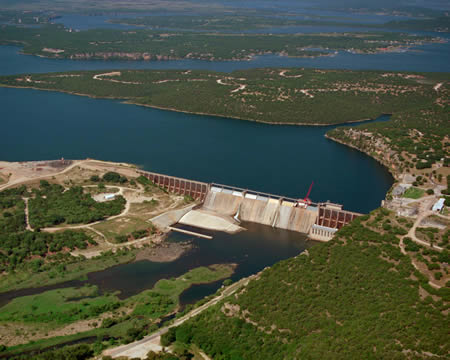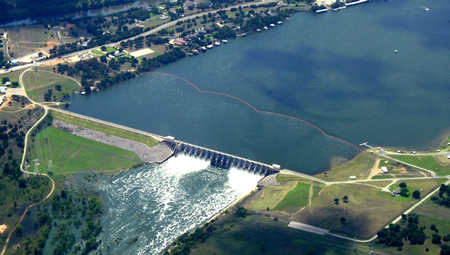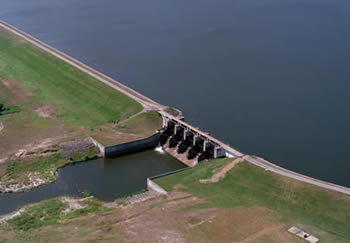You are out near the Brazos River when in the distance upstream you hear a warning horn sound.
Soon the riverbed fills as water rises, heading downstream. The Brazos River Authority has opened a gate at a nearby lake and is releasing water.
Whether you use Brazos basin water in your home or work, or if you like to have fun on one of the Authority’s
lake, you would likely be unable to do so had these dams not been built.
The dams at lakes Possum Kingdom, Granbury and Limestone are the backbone of the Authority’s reservoir system.
These huge barriers hold back an astounding volume of water (more than 175 billion gallons in Possum Kingdom alone).
Here’s a look at each reservoir’s dam, its history and how it works.
Morris Sheppard Dam at Possum Kingdom Lake:
The first built by the Authority, Morris Sheppard Dam was completed in 1941 with help from the
Depression-era Works Progress Administration. It was named after U.S. Sen. Morris Sheppard of Texas, who helped secure federal funds to build the dam and Possum Kingdom Lake.

Like the other two dams that create the Authority reservoirs, the structure is known as a buttress dam, with
a watertight wall facing the lake, supported by buttresses on the downstream side. Morris Sheppard’s’ gates are located in the middle, with a
wing of buttresses on either side.
Morris Sheppard Dam is 2,700 feet long and 190 feet high. It holds about 540,000 acre-feet of water. An acre-foot
equals 325,851 gallons. The dam has nine steel roof weir type gates, also known as bear-trap gates due to their design. Each gate is about 74 feet long and 13 feet high.
These gates are unique among the Authority dams. They do not require a mechanical system to raise and lower them.
However, unlike the newer dams, which can use a remotely operated computer to move the gates, the gates are operated manually using pressure from lake water to help them open and close.
This process requires an operator to physically climb on top of the gate, attached by a tether above a 190-foot
drop, to unlatch a series of locks that secure the gate in the closed position when not in use.
For a slideshow of a worker locking down a gate, click here.
Because of this design, each gate can only be operated either fully open or fully closed. When each gate is open the
release is about 9,600 cubic feet per second when the lake is full. These types of gates are rarely used in new dams because of the manual system.
De Cordova Bend Dam at Lake Granbury:

The next dam downriver was the second built in the Authority system. De Cordova Bend Dam, completed in 1969, is
2,200 feet long and 84 feet high, holding back a storage capacity of about 129,000 acre-feet. It also uses buttresses on the downstream side.
The dam was named for Jacob De Cordova, a 19th Century Jamaican newspaper owner and Texas legislator.
De Cordova Bend Dam has 16 Tainter gates, which, unlike those at Possum Kingdom, may be operated electronically via remote computer and can be opened incrementally to
release varying amounts of water beneath the gate.
Sterling C. Robertson Dam at Lake Limestone:
This dam, completed in 1978, holds back about 225,440 acre-feet of water in Lake Limestone on the Navasota River.

The dam is named for Sterling Clack Robertson. This early Texan was the land agent of Robertson’s Colony, which covered
most of 17 present-day Texas counties including the area around the lake. He also served during the battles of New Orleans and San Jacinto and was a senator in the Texas Republic.
The dam is 72 feet tall, 11,395 feet long and is made of earth and concrete and includes a 3,000-foot emergency spillway. The concrete
central section includes buttresses and five Tainter gates, each measuring 40 feet by 28 feet. As with the Lake Granbury dam, these gates release water from below and each may be
opened remotely by computer, incrementally allowing varying amounts of lake water to pass.
Water passing through this dam flows down the Navasota River, joining the Brazos at it’s confluence in Grimes and Washington Counties.